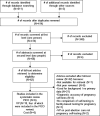Self-testing for pregnancy: a systematic review and meta-analysis
- PMID: 35228285
- PMCID: PMC8886405
- DOI: 10.1136/bmjopen-2021-054120
Self-testing for pregnancy: a systematic review and meta-analysis
Abstract
Objectives: Urine pregnancy tests are often inaccessible in low-income settings. Expanded provision of home pregnancy testing could support self-care options for sexual and reproductive health and rights. We conducted a systematic review of pregnancy self-testing effectiveness, values and preferences and cost.
Design: Systematic review and meta-analysis using the Grading of Recommendation, Assessment, Development, and Evaluation (GRADE) approach.
Data sources: PubMed, CINAHL, LILACS and EMBASE and four trial registries were searched through 2 November 2020.
Eligibility criteria for selecting studies: We included trials and observational studies that compared urine self-testing for pregnancy to health worker-led pregnancy testing on effectiveness outcomes; quantitative and qualitative studies describing values and preferences of end users and health workers and costs of pregnancy self-testing.
Data extraction and synthesis: Two independent reviewers used standardised methods to search, screen and code included studies. Risk of bias was assessed using the Cochrane Collaboration and Evidence Project tools. Meta-analysis was conducted using random effects models. Findings were summarised in GRADE evidence profiles and synthesised qualitatively.
Results: For effectiveness, four randomised trials following 5493 individuals after medical abortion showed no difference or improvements in loss to follow-up with home pregnancy self-testing compared with return clinic visits. One additional trial of community health workers offering home pregnancy tests showed a significant increase in pregnancy knowledge and antenatal counselling among 506 clients. Eighteen diverse values and preferences studies found support for pregnancy self-testing because of quick results, convenience, confidentiality/privacy, cost and accuracy. Most individuals receiving pregnancy self-tests for postabortion home management preferred this option. No studies reported cost data.
Conclusion: Pregnancy self-testing is acceptable and valued by end users. Effectiveness data come mostly from articles on postabortion care, and cost data are lacking. Greater availability of pregnancy self-tests, including in postabortion care and CHW programs, may lead to improved health outcomes.
Prospero registration number: CRD42021231656.
Keywords: maternal medicine; organisation of health services; protocols & guidelines; public health.
© Author(s) (or their employer(s)) 2022. Re-use permitted under CC BY-NC. No commercial re-use. See rights and permissions. Published by BMJ.
Conflict of interest statement
Competing interests: None declared.
Figures


References
Publication types
MeSH terms
Grants and funding
LinkOut - more resources
Full Text Sources
Medical
